Laser Interference Lithography—A Method for the Fabrication of Controlled Periodic Structures
Abstract
1. Introduction
2. Laser Interference Lithography
2.1. Types of Laser Interference Lithography
2.2. Influence of the Process Parameters for Laser Interference Lithography
- The number of laser beams producing different micro- and nanoarray structures;
- The incident angle preparing the grating structure of different periods;
- The azimuth angle producing different morphology arrays;
- The energy of the laser determining the depth of the structure; and
- The polarization state determining the pattern profile.
2.2.1. The Number of Laser Beams
2.2.2. The Azimuthal Angles
2.2.3. The Energy of the Laser
2.2.4. The Polarization State
3. Applications of LIL
3.1. Solar Panels with Anti-Reflection Properties
3.2. Tunable Structural Color and Photonic Crystal
3.3. Patterned Nanoparticles
3.3.1. Catalytic Performance
3.3.2. SERS
3.4. Biological Field—Biological Cell Regulation
3.5. Processing of Functional Surface Structural Components
3.5.1. Hydrophobic and Anti-Ice/Frost Properties
3.5.2. Friction Reduction, and Hardness Enhancement
4. Current Challenges and Prospects
- High operating environment requirements: Due to the high number of optical components of the equipment, various optical components are sensitive to impurities in the surrounding environment and require a high-standard clean room; optical mirror frames are sensitive to vibration and require an optical platform for vibration filtering that otherwise affects stability;
- High equipment cost: The cost of laser interference lithography equipment is greater than the traditional lithography equipment (e.g., laser marking machine, etc.) because of the need to use lasers, optical anti-vibration platforms, displacement tables, the need for more optical lenses, and their fixing equipment; and
- Restricted material types: Due to the selectivity of materials to the laser wavelength, the laser with a certain wavelength is only applicable to certain materials, such as the wavelength of 1064 nm can process metals, silicon-based semiconductors, etc. Other materials, such as glasses, plastics, and other organic materials, have a poor etching effect, and the interferometric system needs to replace the UV laser and corresponding optical components.
Author Contributions
Funding
Data Availability Statement
Conflicts of Interest
References
- Bhushan, B.; Jung, Y.C. Natural and biomimetic artificial surfaces for superhydrophobicity, self-cleaning, low adhesion, and drag reduction. Prog. Mater. Sci. 2011, 56, 1–108. [Google Scholar] [CrossRef]
- Xia, F.; Jiang, L. Bio-Inspired, Smart, Multiscale Interfacial Materials. Adv. Mater. 2008, 20, 2842–2858. [Google Scholar] [CrossRef]
- Malshe, A.P.; Bapat, S.; Rajurkar, K.P.; Haitjema, H. Bio-inspired textures for functional applications. CIRP Ann. 2018, 67, 627–650. [Google Scholar] [CrossRef]
- Si, Y.; Dong, Z.; Jiang, L. Bioinspired Designs of Superhydrophobic and Superhydrophilic Materials. ACS Cent. Sci. 2018, 4, 1102–1112. [Google Scholar] [CrossRef]
- Tan, Y.; Hu, B.; Song, J.; Chu, Z.; Wu, W. Bioinspired Multiscale Wrinkling Patterns on Curved Substrates: An Overview. Nano-Micro Lett. 2020, 12, 1–42. [Google Scholar] [CrossRef]
- Liu, K.; Jiang, L. Bio-inspired design of multiscale structures for function integration. Nano Today 2011, 6, 155–175. [Google Scholar] [CrossRef]
- Su, B.; Tian, Y.; Jiang, L. Bioinspired Interfaces with Superwettability: From Materials to Chemistry. J. Am. Chem. Soc. 2016, 138, 1727–1748. [Google Scholar] [CrossRef]
- Zhang, S.; Huang, J.; Cheng, Y.; Yang, H.; Chen, Z.; Lai, Y. Bioinspired Surfaces with Superwettability for Anti-Icing and Ice-Phobic Application: Concept, Mechanism, and Design. Small 2017, 13, 1701867. [Google Scholar] [CrossRef]
- Xu, J.; Xiu, S.; Lian, Z.; Yu, H.; Cao, J. Bioinspired materials for droplet manipulation: Principles, methods and applications. Droplet 2022, 1, 11–37. [Google Scholar] [CrossRef]
- Sun, Q.; Wang, D.; Li, Y.; Zhang, J.; Ye, S.; Cui, J.; Chen, L.; Wang, Z.; Butt, H.J.; Vollmer, D.; et al. Surface charge printing for programmed droplet transport. Nat. Mater. 2019, 18, 936–941. [Google Scholar] [CrossRef]
- Wang, F.; Sun, Y.; Zong, G.; Liang, W.; Yang, B.; Guo, F.; Yangou, C.; Wang, Y.; Zhang, Z. Electrothermally Assisted Surface Charge Density Gradient Printing to Drive Droplet Transport. ACS Appl. Mater. Interfaces 2022, 14, 3526–3535. [Google Scholar] [CrossRef] [PubMed]
- Morales, A.T.; Tamayo Fajardo, J.A.; Gonzalez-Garcia, H. High-Speed Swimsuits and Their Historical Development in Competitive Swimming. Front. Psychol. 2019, 10, 2639. [Google Scholar] [CrossRef]
- Dean, B.; Bhushan, B. Shark-skin surfaces for fluid-drag reduction in turbulent flow: A review. Philos. Trans. A Math. Phys. Eng. Sci. 2010, 368, 4775–4806. [Google Scholar] [CrossRef] [PubMed]
- Zhang, C.; McAdams, D.A., 2nd; Grunlan, J.C. Nano/Micro-Manufacturing of Bioinspired Materials: A Review of Methods to Mimic Natural Structures. Adv. Mater. 2016, 28, 6292–6321. [Google Scholar] [CrossRef]
- Chen, Y.; Meng, J.; Gu, Z.; Wan, X.; Jiang, L.; Wang, S. Bioinspired Multiscale Wet Adhesive Surfaces: Structures and Controlled Adhesion. Adv. Funct. Mater. 2019, 30, 1905287. [Google Scholar] [CrossRef]
- Rodriguez, A.; Echeverría, M.; Ellman, M.; Perez, N.; Verevkin, Y.K.; Peng, C.S.; Berthou, T.; Wang, Z.; Ayerdi, I.; Savall, J.; et al. Laser interference lithography for nanoscale structuring of materials: From laboratory to industry. Microelectron. Eng. 2009, 86, 937–940. [Google Scholar] [CrossRef]
- Lasagni, A. Bringing the Direct Laser Interference Patterning Method to Industry: A One Tool-Complete Solution for Surface Functionalization. J. Laser Micro/Nanoeng. 2015, 10, 340–344. [Google Scholar] [CrossRef]
- Cardoso, J.T.; Aguilar-Morales, A.I.; Alamri, S.; Huerta-Murillo, D.; Cordovilla, F.; Lasagni, A.F.; Ocaña, J.L. Superhydrophobicity on hierarchical periodic surface structures fabricated via direct laser writing and direct laser interference patterning on an aluminium alloy. Opt. Lasers Eng. 2018, 111, 193–200. [Google Scholar] [CrossRef]
- Wu, H.; Jiao, Y.; Zhang, C.; Chen, C.; Yang, L.; Li, J.; Ni, J.; Zhang, Y.; Li, C.; Zhang, Y.; et al. Large area metal micro-/nano-groove arrays with both structural color and anisotropic wetting fabricated by one-step focused laser interference lithography. Nanoscale 2019, 11, 4803–4810. [Google Scholar] [CrossRef]
- Yu, F.; Li, P.; Shen, H.; Mathur, S.; Lehr, C.M.; Bakowsky, U.; Mucklich, F. Laser interference lithography as a new and efficient technique for micropatterning of biopolymer surface. Biomaterials 2005, 26, 2307–2312. [Google Scholar] [CrossRef]
- Shimizu, Y. Laser Interference Lithography for Fabrication of Planar Scale Gratings for Optical Metrology. Nanomanuf. Metrol. 2021, 4, 3–27. [Google Scholar] [CrossRef]
- Lu, C.; Lipson, R.H. Interference lithography: A powerful tool for fabricating periodic structures. Laser Photonics Rev. 2010, 4, 568–580. [Google Scholar] [CrossRef]
- Seo, J.H.; Park, J.H.; Kim, S.I.; Park, B.J.; Ma, Z.; Choi, J.; Ju, B.K. Nanopatterning by laser interference lithography: Applications to optical devices. J. Nanosci. Nanotechnol. 2014, 14, 1521–1532. [Google Scholar] [CrossRef] [PubMed]
- Wang, L.; Lu, Z.-H.; Lin, X.-F.; Chen, Q.-D.; Xu, B.-B.; Sun, H.-B. Rapid Fabrication of Large-Area Periodic Structures by Multiple Exposure of Two-Beam Interference. J. Light. Technol. 2013, 31, 276–281. [Google Scholar] [CrossRef]
- Wang, D.; Wang, Z.; Zhang, Z.; Yue, Y.; Li, D.; Maple, C. Direct modification of silicon surface by nanosecond laser interference lithography. Appl. Surf. Sci. 2013, 282, 67–72. [Google Scholar] [CrossRef]
- Wang, D.; Wang, Z.; Zhang, Z.; Yue, Y.; Li, D.; Maple, C. Effects of polarization on four-beam laser interference lithography. Appl. Phys. Lett. 2013, 102, 081903. [Google Scholar] [CrossRef]
- Zhang, J.; Wang, Z.; Di, X.; Zhao, L.; Wang, D. Effects of azimuthal angles on laser interference lithography. Appl. Opt. 2014, 53, 6294–6301. [Google Scholar] [CrossRef]
- Zhang, Z.; Wang, Z.; Wang, D.; Ding, Y. Periodic antireflection surface structure fabricated on silicon by four-beam laser interference lithography. J. Laser Appl. 2014, 26, 012010. [Google Scholar] [CrossRef]
- He, J.; Fang, X.; Lin, Y.; Zhang, X. Polarization control in flexible interference lithography for nano-patterning of different photonic structures with optimized contrast. Opt. Express 2015, 23, 11518–11525. [Google Scholar] [CrossRef]
- Zhao, L.; Wang, Z.; Zhang, J.; Yu, M.; Li, S.; Li, D.; Yue, Y. Effects of laser fluence on silicon modification by four-beam laser interference. J. Appl. Phys. 2015, 118, 233106. [Google Scholar] [CrossRef]
- Zhao, L.; Wang, Z.; Zhang, J.; Cao, L.; Li, L.; Yue, Y.; Li, D. Antireflection silicon structures with hydrophobic property fabricated by three-beam laser interference. Appl. Surf. Sci. 2015, 346, 574–579. [Google Scholar] [CrossRef]
- Ellman, M.; Rodríguez, A.; Pérez, N.; Echeverria, M.; Verevkin, Y.K.; Peng, C.S.; Berthou, T.; Wang, Z.; Olaizola, S.M.; Ayerdi, I. High-power laser interference lithography process on photoresist: Effect of laser fluence and polarisation. Appl. Surf. Sci. 2009, 255, 5537–5541. [Google Scholar] [CrossRef]
- Zhou, Z.; Song, Z.; Li, L.; Zhang, J.; Wang, Z. Fabrication of periodic variable-sized Pt nanoparticles via laser interference patterning. Appl. Surf. Sci. 2015, 335, 65–70. [Google Scholar] [CrossRef]
- Andreani, L.C.; Bozzola, A.; Kowalczewski, P.; Liscidini, M.; Redorici, L. Silicon solar cells: Toward the efficiency limits. Adv. Phys. X 2018, 4, 1548305. [Google Scholar] [CrossRef]
- Mohammad Bagher, A. Types of Solar Cells and Application. Am. J. Opt. Photonics 2015, 3, 94–113. [Google Scholar] [CrossRef]
- Fraas, L.M. History of Solar Cell Development. In Low-Cost Solar Electric Power; Springer: Cham, Switzerland, 2014; pp. 1–12. [Google Scholar] [CrossRef]
- Kirchartz, T.; Rau, U. What Makes a Good Solar Cell? Adv. Energy Mater. 2018, 8, 1703385. [Google Scholar] [CrossRef]
- Lian, Z.; Xu, J.; Yu, Z.; Yu, P.; Ren, W.; Wang, Z.; Yu, H. Bioinspired Reversible Switch between Underwater Superoleophobicity/Superaerophobicity and Oleophilicity/Aerophilicity and Improved Antireflective Property on the Nanosecond Laser-Ablated Superhydrophobic Titanium Surfaces. ACS Appl. Mater. Interfaces 2020, 12, 6573–6580. [Google Scholar] [CrossRef]
- Cai, J.; Qi, L. Recent advances in antireflective surfaces based on nanostructure arrays. Mater. Horiz. 2015, 2, 37–53. [Google Scholar] [CrossRef]
- Lin, Y.; Harb, A.; Rodriguez, D.; Lozano, K.; Xu, D.; Chen, K.P. Holographic fabrication of photonic crystals using multidimensional phase masks. J. Appl. Phys. 2008, 104, 113111. [Google Scholar] [CrossRef]
- Behera, S.; Sarkar, S.; Joseph, J. Fabrication of helical photonic structures with submicrometer axial and spatial periodicities following “inverted umbrella” geometry through phase-controlled interference lithography. Opt. Lett. 2018, 43, 106–109. [Google Scholar] [CrossRef]
- Nebel, C.E.; Dahlheimer, B.; Schöniger, S.; Stutzmann, M. Sub-micron silicon structures for thin film solar cells. Phys. Status Solidi (b) 1996, 194, 55–67. [Google Scholar] [CrossRef]
- Dong, L.; Zhang, Z.; Ding, R.; Wang, L.; Liu, M.; Weng, Z.; Wang, Z.; Li, D. Controllable superhydrophobic surfaces with tunable adhesion fabricated by laser interference lithography. Surf. Coat. Technol. 2019, 372, 434–441. [Google Scholar] [CrossRef]
- Dong, L.; Zhang, Z.; Wang, Z.; Li, D.; Liu, M. Design an Asymmetrical Three-Beam Laser Interference Lithography for Fabricating Micro- and Nano-Structures. J. Laser Micro/Nanoeng. 2020, 15, 85–91. [Google Scholar] [CrossRef]
- Dong, L.; Zhang, Z.; Wang, L.; Weng, Z.; Ouyang, M.; Fu, Y.; Wang, J.; Li, D.; Wang, Z. Fabrication of hierarchical moth-eye structures with durable superhydrophobic property for ultra-broadband visual and mid-infrared applications. Appl. Opt. 2019, 58, 6706–6712. [Google Scholar] [CrossRef] [PubMed]
- Ha, B.-H.; Ahn, S.; Bae, H.-S.; Kang, H.-S.; Kim, J.-o.; Noh, J. Fast and direct engraving of iridescent lettering on original product surface using laser interference to prevent counterfeiting. Opt. Lasers Eng. 2018, 107, 214–220. [Google Scholar] [CrossRef]
- Voisiat, B.; Wang, W.; Holzhey, M.; Lasagni, A.F. Improving the homogeneity of diffraction based colours by fabricating periodic patterns with gradient spatial period using Direct Laser Interference Patterning. Sci. Rep. 2019, 9, 7801. [Google Scholar] [CrossRef]
- Rekola, H.; Berdin, A.; Fedele, C.; Virkki, M.; Priimagi, A. Digital holographic microscopy for real-time observation of surface-relief grating formation on azobenzene-containing films. Sci. Rep. 2020, 10, 19642. [Google Scholar] [CrossRef]
- Chen, L.; Cao, K.; Li, Y.; Liu, J.; Zhang, S.; Feng, D.; Sun, Z.; Jia, T. Large-area straight, regular periodic surface structures produced on fused silica by the interference of two femtosecond laser beams through cylindrical lens. Opto-Electron. Adv. 2021, 4, 200036. [Google Scholar] [CrossRef]
- Gan, Z.; Feng, H.; Chen, L.; Min, S.; Liang, C.; Xu, M.; Jiang, Z.; Sun, Z.; Sun, C.; Cui, D.; et al. Spatial modulation of nanopattern dimensions by combining interference lithography and grayscale-patterned secondary exposure. Light Sci. Appl. 2022, 11, 89. [Google Scholar] [CrossRef]
- John, S. Strong localization of photons in certain disordered dielectric superlattices. Phys. Rev. Lett. 1987, 58, 2486–2489. [Google Scholar] [CrossRef]
- Yablonovitch, E. Inhibited Spontaneous Emission in Solid-State Physics and Electronics. Phys. Rev. Lett. 1987, 58, 2059–2062. [Google Scholar] [CrossRef] [PubMed]
- Nair, R.V.; Vijaya, R. Photonic crystal sensors: An overview. Prog. Quantum Electron. 2010, 34, 89–134. [Google Scholar] [CrossRef]
- Biswas, U.; Nayak, C.; Rakshit, J.K. Fabrication techniques and applications of two-dimensional photonic crystal: History and the present status. Opt. Eng. 2022, 62, 010901. [Google Scholar] [CrossRef]
- Celler, G.K.; Cristoloveanu, S. Frontiers of silicon-on-insulator. J. Appl. Phys. 2003, 93, 4955–4978. [Google Scholar] [CrossRef]
- Chiu, W.-Y.; Huang, T.-W.; Wu, Y.-H.; Chan, Y.-J.; Hou, C.-H.; Chien, H.-T.; Chen, C.-C. A photonic crystal ring resonator formed by SOI nano-rods. Opt. Express 2007, 15, 15500–15506. [Google Scholar] [CrossRef]
- Faneca, J.; Perova, T.S.; Tolmachev, V.; Baldycheva, A. One-Dimensional Multi-Channel Photonic Crystal Resonators Based on Silicon-On-Insulator With High Quality Factor. Front. Phys. 2018, 6, 33. [Google Scholar] [CrossRef]
- Yu, S.Y.; Tian, Z.Q.; Yang, D.P.; Zhou, X.B.; Ma, D.K.; Huang, S.M. Refractive-Index-Matching-Based Encryption of Photonic Crystal Prints with Multistage and Reconfigurable Information. Adv. Mater. Interfaces 2021, 8, 2100789. [Google Scholar] [CrossRef]
- Semenova, A.A.; Semenov, A.P.; Goodilin, E.A.; Semenova, I.A. Synthesis of Plasmonic Photonic Crystal SiO2–Ag Nanostructures by Ion Beam Deposition of Silver Clusters onto Silica Microspheres. Bull. Russ. Acad. Sci. Phys. 2019, 83, 1415–1418. [Google Scholar] [CrossRef]
- Chen, H.; Chiasera, A.; Varas, S.; Sayginer, O.; Armellini, C.; Speranza, G.; Suriano, R.; Ferrari, M.; Pietralunga, S.M. (INVITED) Tungsten oxide films by radio-frequency magnetron sputtering for near-infrared photonics. Opt. Mater. X 2021, 12, 100093. [Google Scholar] [CrossRef]
- Xing, W.; Li, Z.; Yang, H.; Li, X.; Wang, X.; Li, N. Anti-icing aluminum alloy surface with multi-level micro-nano textures constructed by picosecond laser. Mater. Des. 2019, 183, 108156. [Google Scholar] [CrossRef]
- Wei, H.Y.; Xu, Q.; Chen, D.C.; Chen, M.; Chang, M.L.; Ye, X.F. Lowered infrared emittance and enhanced thermal stability of solar selective absorption properties of anodic aluminum oxide photonic crystal coatings. Sol. Energy 2022, 241, 592–600. [Google Scholar] [CrossRef]
- Sizova, S.; Shakurov, R.; Mitko, T.; Shirshikov, F.; Solovyeva, D.; Konopsky, V.; Alieva, E.; Klinov, D.; Bespyatykh, J.; Basmanov, D. The Elaboration of Effective Coatings for Photonic Crystal Chips in Optical Biosensors. Polymers 2021, 14, 152. [Google Scholar] [CrossRef] [PubMed]
- Liu, C.; Wang, J.; Wang, F.; Su, W.; Yang, L.; Lv, J.; Fu, G.; Li, X.; Liu, Q.; Sun, T.; et al. Surface plasmon resonance (SPR) infrared sensor based on D-shape photonic crystal fibers with ITO coatings. Opt. Commun. 2020, 464, 125496. [Google Scholar] [CrossRef]
- Shieh, J.Y.; Kuo, J.Y.; Weng, H.P.; Yu, H.H. Preparation and evaluation of the bioinspired PS/PDMS photochromic films by the self-assembly dip-drawing method. Langmuir 2013, 29, 667–672. [Google Scholar] [CrossRef] [PubMed]
- Panfilova, E.; Syritskii, A.; Ibragimov, A. Optimization of the photonic crystal colloidal films deposition by means of atomic force microscopy. In IOP Conference Series: Materials Science and Engineering; IOP Publishing: Bristol, UK, 2019; p. 012034. [Google Scholar] [CrossRef]
- Ehrhardt, M.; Lorenz, P.; Bauer, J.; Heinke, R.; Hossain, M.A.; Han, B.; Zimmer, K. Dry Etching of Germanium with Laser Induced Reactive Micro Plasma. Lasers Manuf. Mater. Process. 2021, 8, 237–255. [Google Scholar] [CrossRef]
- Maksimovic, J.; Mu, H.; Smith, D.; Katkus, T.; Vaiciulis, M.; Aleksiejunas, R.; Seniutinas, G.; Ng, S.H.; Juodkazis, S. Laser-Patterned Alumina Mask and Mask-Less Dry Etch of Si for Light Trapping with Photonic Crystal Structures. Micromachines 2023, 14, 550. [Google Scholar] [CrossRef]
- Baburin, A.; Ivanov, A.; Trofimov, I.; Dobronosovaa, A.; Melentiev, P.; Balykin, V.; Moskalev, D.; Pishchimova, A.; Ganieva, L.; Ryzhikov, I.; et al. Highly Directional Plasmonic Nanolaser Based on High-Performance Noble Metal Film Photonic Crystal. In Proceedings of the Nanophotonics VII, Aachen, Germany, 26–27 April 2017. [Google Scholar] [CrossRef]
- Khan, Y.; Rehman, A.U.; Batool, B.A.; Noor, M.; Butt, M.A.; Kazanskiy, N.L.; Khonina, S.N. Fabrication and Investigation of Spectral Properties of a Dielectric Slab Waveguide Photonic Crystal Based Fano-Filter. Crystals 2022, 12, 226. [Google Scholar] [CrossRef]
- Divliansky, I.B.; Shishido, A.; Khoo, I.-C.; Mayer, T.S.; Pena, D.; Nishimura, S.; Keating, C.D.; Mallouk, T.E. Fabrication of two-dimensional photonic crystals using interference lithography and electrodeposition of CdSe. Appl. Phys. Lett. 2001, 79, 3392–3394. [Google Scholar] [CrossRef]
- Behera, S.; Joseph, J. Single-step optical realization of bio-inspired dual-periodic motheye and gradient-index-array photonic structures. Opt. Lett. 2016, 41, 3579–3582. [Google Scholar] [CrossRef]
- Behera, S.; Joseph, J. Design and fabrication of woodpile photonic structures through phase SLM-based interference lithography for omnidirectional optical filters. Opt. Lett. 2017, 42, 2607–2610. [Google Scholar] [CrossRef]
- Behera, S.; Kumar, M.; Joseph, J. Submicrometer photonic structure fabrication by phase spatial-light-modulator-based interference lithography. Opt. Lett. 2016, 41, 1893–1896. [Google Scholar] [CrossRef] [PubMed]
- Campbell, M.; Sharp, D.N.; Harrison, M.T.; Denning, R.G.; Turberfield, A.J. Fabrication of photonic crystals for the visible spectrum by holographic lithography. Nature 2000, 404, 53–56. [Google Scholar] [CrossRef] [PubMed]
- Sarkar, S.; Samanta, K.; Joseph, J. Method for single-shot fabrication of chiral woodpile photonic structures using phase-controlled interference lithography. Opt. Express 2020, 28, 4347–4361. [Google Scholar] [CrossRef] [PubMed]
- Xu, X.; Zhang, D. The research and progress of micro-fabrication technologies of two-dimensional photonic crystal. Chin. Sci. Bull. 2007, 52, 865–876. [Google Scholar] [CrossRef]
- Zhang, S.; Ma, J.; Li, P.; Zhou, Z.; Gu, Y.; Wu, Z. Hexagonal optical lattices formed by coherent interference among three fundamental Gaussian beams with oblique incidence. Results Phys. 2023, 45, 106245. [Google Scholar] [CrossRef]
- Li, H.; Luo, X.; Du, C.; Chen, X.; Fu, Y. Ag dots array fabricated using laser interference technique for biosensing. Sens. Actuators B Chem. 2008, 134, 940–944. [Google Scholar] [CrossRef]
- Mitsudome, T.; Kaneda, K. Gold nanoparticle catalysts for selective hydrogenations. Green Chem. 2013, 15, 2636–2654. [Google Scholar] [CrossRef]
- Jogschies, L.; Klaas, D.; Kruppe, R.; Rittinger, J.; Taptimthong, P.; Wienecke, A.; Rissing, L.; Wurz, M.C. Recent Developments of Magnetoresistive Sensors for Industrial Applications. Sensors 2015, 15, 28665–28689. [Google Scholar] [CrossRef]
- Corte-Leon, H.; Nabaei, V.; Manzin, A.; Fletcher, J.; Krzysteczko, P.; Schumacher, H.W.; Kazakova, O. Anisotropic magnetoresistance state space of permalloy nanowires with domain wall pinning geometry. Sci. Rep. 2014, 4, 6045. [Google Scholar] [CrossRef]
- McAlpine, M.C.; Ahmad, H.; Wang, D.; Heath, J.R. Highly ordered nanowire arrays on plastic substrates for ultrasensitive flexible chemical sensors. Nat. Mater. 2007, 6, 379–384. [Google Scholar] [CrossRef]
- Brown, S. Developments in Data Storage: Materials Perspective. Platin. Met. Rev. 2012, 56, 262–266. [Google Scholar] [CrossRef]
- Hong, S.; Kang, T.; Choi, D.; Choi, Y.; Lee, L.P. Self-assembled three-dimensional nanocrown array. ACS Nano 2012, 6, 5803–5808. [Google Scholar] [CrossRef] [PubMed]
- Zhao, Y.; Ye, C.; Liu, W.; Chen, R.; Jiang, X. Tuning the composition of AuPt bimetallic nanoparticles for antibacterial application. Angew. Chem. Int. Ed. Engl. 2014, 53, 8127–8131. [Google Scholar] [CrossRef] [PubMed]
- Cho, S.-J.; Jarrett, B.R.; Louie, A.Y.; Kauzlarich, S.M. Gold-coated iron nanoparticles: A novel magnetic resonance agent forT1andT2weighted imaging. Nanotechnology 2006, 17, 640–644. [Google Scholar] [CrossRef]
- Wu, C.H.; Huang, Y.Y.; Chen, P.; Hoshino, K.; Liu, H.; Frenkel, E.P.; Zhang, J.X.; Sokolov, K.V. Versatile immunomagnetic nanocarrier platform for capturing cancer cells. ACS Nano 2013, 7, 8816–8823. [Google Scholar] [CrossRef]
- Bao, F.; Yao, J.L.; Gu, R.A. Synthesis of magnetic Fe2O3/Au core/shell nanoparticles for bioseparation and immunoassay based on surface-enhanced Raman spectroscopy. Langmuir 2009, 25, 10782–10787. [Google Scholar] [CrossRef]
- Wang, L.; Wang, Z.; Li, L.; Zhang, J.; Liu, J.; Hu, J.; Wu, X.; Weng, Z.; Chu, X.; Li, J.; et al. Magnetic-plasmonic Ni@Au core-shell nanoparticle arrays and their SERS properties. RSC Adv. 2020, 10, 2661–2669. [Google Scholar] [CrossRef]
- Malaquin, L.; Kraus, T.; Schmid, H.; Delamarche, E.; Wolf, H. Controlled particle placement through convective and capillary assembly. Langmuir 2007, 23, 11513–11521. [Google Scholar] [CrossRef]
- An, L.; Li, W.; Nie, Y.; Xie, B.; Li, Z.; Zhang, J.; Yang, B. Patterned magnetic rings fabricated by dewetting of polymer-coated magnetite nanoparticles solution. J. Colloid Interface Sci. 2005, 288, 503–507. [Google Scholar] [CrossRef]
- Haaheim, J.; Eby, R.; Nelson, M.; Fragala, J.; Rosner, B.; Zhang, H.; Athas, G. Dip Pen Nanolithography (DPN): Process and instrument performance with NanoInk’s NSCRIPTOR system. Ultramicroscopy 2005, 103, 117–132. [Google Scholar] [CrossRef]
- Liu, N.; Liang, W.; Mai, J.D.; Liu, L.; Lee, G.-B.; Li, W.J. Rapid Fabrication of Nanomaterial Electrodes Using Digitally Controlled Electrokinetics. IEEE Trans. Nanotechnol. 2014, 13, 245–253. [Google Scholar] [CrossRef]
- Giermann, A.L.; Thompson, C.V. Solid-state dewetting for ordered arrays of crystallographically oriented metal particles. Appl. Phys. Lett. 2005, 86, 121903. [Google Scholar] [CrossRef]
- Wang, D.; Ji, R.; Albrecht, A.; Schaaf, P. Ordered arrays of nanoporous gold nanoparticles. Beilstein J. Nanotechnol. 2012, 3, 651–657. [Google Scholar] [CrossRef]
- Bird, S.M.; Rawlings, A.E.; Galloway, J.M.; Staniland, S.S. Using a biomimetic membrane surface experiment to investigate the activity of the magnetite biomineralisation protein Mms6. RSC Adv. 2016, 6, 7356–7363. [Google Scholar] [CrossRef] [PubMed]
- Shen, H.; Wang, Y.; Wang, L.; Wang, S.; Liu, R.; Chu, X.; Zhang, J.; Li, C.; Weng, Z.; Wang, Z. Effect of laser intensity distribution period on the silver micro-stripes by laser interference induced forward transfer technology and their SERS property. J. Nanoparticle Res. 2022, 24, 241. [Google Scholar] [CrossRef]
- Yoo, J.E.; Lee, K.; Altomare, M.; Selli, E.; Schmuki, P. Self-organized arrays of single-metal catalyst particles in TiO2 cavities: A highly efficient photocatalytic system. Angew. Chem. Int. Ed. Engl. 2013, 52, 7514–7517. [Google Scholar] [CrossRef]
- Guo, X.; Li, S.; Lei, Z.; Liu, R.; Li, L.; Wang, L.; Dong, L.; Peng, K.; Wang, Z. Controllable Patterning of Hybrid Silicon Nanowire and Nanohole Arrays by Laser Interference Lithography. Phys. Status Solidi (RRL)–Rapid Res. Lett. 2020, 14, 2000024. [Google Scholar] [CrossRef]
- Guo, X.; Li, L.; Hu, Y.; Cao, L.; Dong, L.; Wang, L.; Ding, R.; Weng, Z.; Song, Z.; Xu, H.; et al. Superlens-enhanced laser interference lithography. Appl. Phys. Express 2018, 11, 125201. [Google Scholar] [CrossRef]
- Fleischmann, M.; Hendra, P.J.; McQuillan, A.J. Raman spectra of pyridine adsorbed at a silver electrode. Chem. Phys. Lett. 1974, 26, 163–166. [Google Scholar] [CrossRef]
- Nie, S.; Emory, S.R. Probing Single Molecules and Single Nanoparticles by Surface-Enhanced Raman Scattering. Science 1997, 275, 1102–1106. [Google Scholar] [CrossRef]
- Gisbert Quilis, N.; Lequeux, M.; Venugopalan, P.; Khan, I.; Knoll, W.; Boujday, S.; Lamy de la Chapelle, M.; Dostalek, J. Tunable laser interference lithography preparation of plasmonic nanoparticle arrays tailored for SERS. Nanoscale 2018, 10, 10268–10276. [Google Scholar] [CrossRef]
- Shen, H.; Wang, Y.; Cao, L.; Xie, Y.; Wang, Y.; Zhang, Q.; Zhang, W.; Wang, S.; Han, Z.; Zhu, X.; et al. Fabrication of periodical micro-stripe structure of polyimide by laser interference induced forward transfer technique. Appl. Surf. Sci. 2021, 541, 148466. [Google Scholar] [CrossRef]
- Shen, H.; Wang, Y.; Cao, L.; Xie, Y.; Wang, L.; Chu, X.; Shi, K.; Wang, S.; Yu, M.; Liu, R.; et al. Fabrication of periodic microscale stripes of silver by laser interference induced forward transfer and their SERS properties. Nanotechnology 2021, 33, 115302. [Google Scholar] [CrossRef] [PubMed]
- Yeo, M.; Kim, G. Micro/nano-hierarchical scaffold fabricated using a cell electrospinning/3D printing process for co-culturing myoblasts and HUVECs to induce myoblast alignment and differentiation. Acta Biomater. 2020, 107, 102–114. [Google Scholar] [CrossRef] [PubMed]
- Cortese, B.; Gigli, G.; Riehle, M. Mechanical Gradient Cues for Guided Cell Motility and Control of Cell Behavior on Uniform Substrates. Adv. Funct. Mater. 2009, 19, 2961–2968. [Google Scholar] [CrossRef]
- Khalil, K.; Eon, A.; Janody, F. Cell Architecture-Dependent Constraints: Critical Safeguards to Carcinogenesis. Int. J. Mol. Sci. 2022, 23, 8622. [Google Scholar] [CrossRef]
- Lee, Y.B.; Kim, E.M.; Byun, H.; Chang, H.K.; Jeong, K.; Aman, Z.M.; Choi, Y.S.; Park, J.; Shin, H. Engineering spheroids potentiating cell-cell and cell-ECM interactions by self-assembly of stem cell microlayer. Biomaterials 2018, 165, 105–120. [Google Scholar] [CrossRef]
- Bjorge, I.M.; Salmeron-Sanchez, M.; Correia, C.R.; Mano, J.F. Cell Behavior within Nanogrooved Sandwich Culture Systems. Small 2020, 16, e2001975. [Google Scholar] [CrossRef]
- Wang, P.Y.; Yu, H.T.; Tsai, W.B. Modulation of alignment and differentiation of skeletal myoblasts by submicron ridges/grooves surface structure. Biotechnol. Bioeng. 2010, 106, 285–294. [Google Scholar] [CrossRef]
- Xiao, M.; Chen, Y.M.; Biao, M.N.; Zhang, X.D.; Yang, B.C. Bio-functionalization of biomedical metals. Mater. Sci. Eng. C Mater. Biol. Appl. 2017, 70, 1057–1070. [Google Scholar] [CrossRef]
- Wu, X.; Li, L.; Wang, L.; Lei, Z.; Yang, F.; Liu, R.; Wang, Y.; Peng, K.; Wang, Z. Cell spreading behaviors on hybrid nanopillar and nanohole arrays. Nanotechnology 2021, 33, 045101. [Google Scholar] [CrossRef] [PubMed]
- Liu, Q.; Li, W.; Cao, L.; Wang, J.; Qu, Y.; Wang, X.; Qiu, R.; Di, X.; Wang, Z.; Liang, B. Response of MG63 osteoblast cells to surface modification of Ti-6Al-4V implant alloy by laser interference lithography. J. Bionic Eng. 2017, 14, 448–458. [Google Scholar] [CrossRef]
- Wang, D.; Sun, Q.; Hokkanen, M.J.; Zhang, C.; Lin, F.Y.; Liu, Q.; Zhu, S.P.; Zhou, T.; Chang, Q.; He, B.; et al. Design of robust superhydrophobic surfaces. Nature 2020, 582, 55–59. [Google Scholar] [CrossRef] [PubMed]
- Zhao, M.; Yang, Z.; Zhao, J.; Shrotriya, P.; Wang, Y.; Cui, Y.; Guo, Z. Ultrasonic vibration assisted laser (UVAL) treatment of copper for superhydrophobicity. Surf. Coat. Technol. 2021, 421, 127386. [Google Scholar] [CrossRef]
- Tian, Z.; Wang, L.; Zhu, D.; Chen, C.; Zhao, H.; Peng, R.; Zhang, H.; Fan, P.; Zhong, M. Passive Anti-Icing Performances of the Same Superhydrophobic Surfaces under Static Freezing, Dynamic Supercooled-Droplet Impinging, and Icing Wind Tunnel Tests. ACS Appl. Mater. Interfaces 2023, 15, 6013–6024. [Google Scholar] [CrossRef]
- Zhang, W.; Wang, D.; Sun, Z.; Song, J.; Deng, X. Robust superhydrophobicity: Mechanisms and strategies. Chem. Soc. Rev. 2021, 50, 4031–4061. [Google Scholar] [CrossRef]
- McHale, G.; Orme, B.V.; Wells, G.G.; Ledesma-Aguilar, R. Apparent Contact Angles on Lubricant-Impregnated Surfaces/SLIPS: From Superhydrophobicity to Electrowetting. Langmuir 2019, 35, 4197–4204. [Google Scholar] [CrossRef]
- Koch, K.; Bhushan, B.; Jung, Y.C.; Barthlott, W. Fabrication of artificial Lotus leaves and significance of hierarchical structure for superhydrophobicity and low adhesion. Soft Matter 2009, 5, 1386–1393. [Google Scholar] [CrossRef]
- Wang, L.; Jiang, G.; Tian, Z.; Chen, C.; Hu, X.; Peng, R.; Zhang, H.; Fan, P.; Zhong, M. Superhydrophobic microstructures for better anti-icing performances: Open-cell or closed-cell? Mater. Horiz. 2023, 10, 209–220. [Google Scholar] [CrossRef]
- Wang, L.; Tian, Z.; Jiang, G.; Luo, X.; Chen, C.; Hu, X.; Zhang, H.; Zhong, M. Spontaneous dewetting transitions of droplets during icing & melting cycle. Nat. Commun. 2022, 13, 378. [Google Scholar] [CrossRef]
- Pan, R.; Zhang, H.; Zhong, M. Triple-Scale Superhydrophobic Surface with Excellent Anti-Icing and Icephobic Performance via Ultrafast Laser Hybrid Fabrication. ACS Appl. Mater. Interfaces 2021, 13, 1743–1753. [Google Scholar] [CrossRef]
- Zhuo, Y.; Håkonsen, V.; Liu, S.; Li, T.; Wang, F.; Luo, S.; Xiao, S.; He, J.; Zhang, Z. Ultra-robust icephobic coatings with high toughness, strong substrate adhesion and self-healing capability. Sci. China Mater. 2023, 66, 2071–2078. [Google Scholar] [CrossRef]
- Cui, Y.-W.; Chen, L.-Y.; Chu, Y.-H.; Zhang, L.; Li, R.; Lu, S.; Wang, L.; Zhang, L.-C. Metastable pitting corrosion behavior and characteristics of passive film of laser powder bed fusion produced Ti–6Al–4V in NaCl solutions with different concentrations. Corros. Sci. 2023, 215, 111017. [Google Scholar] [CrossRef]
- Kuczyńska-Zemła, D.; Sotniczuk, A.; Pisarek, M.; Chlanda, A.; Garbacz, H. Corrosion behavior of titanium modified by direct laser interference lithography. Surf. Coat. Technol. 2021, 418, 127219. [Google Scholar] [CrossRef]
- Li, X.; Jiang, Y.; Jiang, Z.; Li, Y.; Wen, C.; Zhang, D.; Lian, J.; Zhang, Z. Improvement of corrosion resistance of H59 brass through fabricating superhydrophobic surface using laser ablation and heating treatment. Corros. Sci. 2021, 180, 109186. [Google Scholar] [CrossRef]
- Zhang, X.; Lu, Q.; Yan, Y.; Zhang, T.; Liu, S.; Cai, M.; Ye, Q.; Zhou, F.; Liu, W. Tribochemical synthesis of functionalized covalent organic frameworks for anti-wear and friction reduction. Friction 2023, 10, 1237. [Google Scholar] [CrossRef]
- Wei, X.; Li, W.; Liang, B.; Li, B.; Zhang, J.; Zhang, L.; Wang, Z. Surface modification of Co–Cr–Mo implant alloy by laser interference lithography. Tribol. Int. 2016, 97, 212–217. [Google Scholar] [CrossRef]
- Zheng, J.; Liu, R.; Liu, D.; Weng, Z.; Song, G.; Li, W.; Wang, Z. Slippery liquid infused porous surfaces with anti-icing performance fabricated by direct laser interference lithography. Prog. Org. Coat. 2023, 175, 107308. [Google Scholar] [CrossRef]
- Han, T.; Liu, Y.; Liao, M.; Yang, D.; Qu, N.; Lai, Z.; Zhu, J. Refined microstructure and enhanced mechanical properties of AlCrFe2Ni2 medium entropy alloy produced via laser remelting. J. Mater. Sci. Technol. 2022, 99, 18–27. [Google Scholar] [CrossRef]
- Sun, X.; Luo, Y.; Wang, J.; Wang, Q.; Qiao, J.; Beadling, A.; Bryant, M.; Jin, Z. Structure, tribological properties, and the growth mechanism of in-situ generated TiC in titanium cermet. Friction 2021, 10, 706–716. [Google Scholar] [CrossRef]
- Gu, D.; Hagedorn, Y.-C.; Meiners, W.; Wissenbach, K.; Poprawe, R. Nanocrystalline TiC reinforced Ti matrix bulk-form nanocomposites by Selective Laser Melting (SLM): Densification, growth mechanism and wear behavior. Compos. Sci. Technol. 2011, 71, 1612–1620. [Google Scholar] [CrossRef]
- Zhang, H.; Ly, K.C.S.; Liu, X.; Chen, Z.; Yan, M.; Wu, Z.; Wang, X.; Zheng, Y.; Zhou, H.; Fan, T. Biologically inspired flexible photonic films for efficient passive radiative cooling. Proc. Natl. Acad. Sci. USA 2020, 117, 14657–14666. [Google Scholar] [CrossRef] [PubMed]
- Xu, J.; Hou, Y.; Lian, Z.; Yu, Z.; Wang, Z.; Yu, H. Bio-Inspired Design of Bi/Tridirectionally Anisotropic Sliding Superhydrophobic Titanium Alloy Surfaces. Nanomaterials 2020, 10, 2140. [Google Scholar] [CrossRef]
- Chen, D.; Li, J.; Zhao, J.; Guo, J.; Zhang, S.; Sherazi, T.A.; Ambreen; Li, S. Bioinspired superhydrophilic-hydrophobic integrated surface with conical pattern-shape for self-driven fog collection. J. Colloid Interface Sci. 2018, 530, 274–281. [Google Scholar] [CrossRef]
- Stratakis, E.; Ranella, A.; Fotakis, C. Biomimetic micro/nanostructured functional surfaces for microfluidic and tissue engineering applications. Biomicrofluidics 2011, 5, 13411. [Google Scholar] [CrossRef] [PubMed]
- Guo, Z.; Liu, W. Biomimic from the superhydrophobic plant leaves in nature: Binary structure and unitary structure. Plant Sci. 2007, 172, 1103–1112. [Google Scholar] [CrossRef]
- Vercillo, V.; Karpen, N.; Laroche, A.; Mayén Guillén, J.A.; Tonnicchia, S.; de Andrade Jorge, R.; Bonaccurso, E. Analysis and modelling of icing of air intake protection grids of aircraft engines. Cold Reg. Sci. Technol. 2019, 160, 265–272. [Google Scholar] [CrossRef]
- Irajizad, P.; Nazifi, S.; Ghasemi, H. Icephobic surfaces: Definition and figures of merit. Adv. Colloid Interface Sci. 2019, 269, 203–218. [Google Scholar] [CrossRef]
- Gam-Derouich, S.; Pinson, J.; Lamouri, A.; Decorse, P.; Bellynck, S.; Herbaut, R.; Royon, L.; Mangeney, C. Micro-patterned anti-icing coatings with dual hydrophobic/hydrophilic properties. J. Mater. Chem. A 2018, 6, 19353–19357. [Google Scholar] [CrossRef]
- Shi, W.; Wang, L.; Guo, Z.; Zheng, Y. Excellent Anti-Icing Abilities of Optimal Micropillar Arrays with Nanohairs. Adv. Mater. Interfaces 2015, 2, 1500352. [Google Scholar] [CrossRef]
- Wang, T.; Zheng, Y.; Raji, A.R.; Li, Y.; Sikkema, W.K.; Tour, J.M. Passive Anti-Icing and Active Deicing Films. ACS Appl. Mater. Interfaces 2016, 8, 14169–14173. [Google Scholar] [CrossRef] [PubMed]
- Shen, Y.; Tao, J.; Tao, H.; Chen, S.; Pan, L.; Wang, T. Nanostructures in superhydrophobic Ti6Al4V hierarchical surfaces control wetting state transitions. Soft Matter 2015, 11, 3806–3811. [Google Scholar] [CrossRef] [PubMed]
- Shen, Y.; Tao, H.; Chen, S.; Zhu, L.; Wang, T.; Tao, J. Icephobic/anti-icing potential of superhydrophobic Ti6Al4V surfaces with hierarchical textures. RSC Adv. 2015, 5, 1666–1672. [Google Scholar] [CrossRef]
- Guo, P.; Zheng, Y.; Wen, M.; Song, C.; Lin, Y.; Jiang, L. Icephobic/anti-icing properties of micro/nanostructured surfaces. Adv. Mater. 2012, 24, 2642–2648. [Google Scholar] [CrossRef] [PubMed]
- Klotzbach, U.; Washio, K.; Arnold, C.B.; Lasagni, A.F.; Roch, T.; Berger, J.; Kunze, T.; Lang, V.; Beyer, E. To use or not to use (direct laser interference patterning), that is the question. In Proceedings of the Laser-Based Micro- and Nanoprocessing IX, San Francisco, CA, USA, 7–12 February 2015. [Google Scholar] [CrossRef]
- Kuisat, F.; Ränke, F.; Baumann, R.; Lasagni, F.; Lasagni, A.F. Fabrication of Water- and Ice-Repellent Surfaces on Additive-Manufactured Components Using Laser-Based Microstructuring Methods. Adv. Eng. Mater. 2022, 24, 2101624. [Google Scholar] [CrossRef]
- El-Khoury, M.; Seifert, M.; Bretschneider, S.; Zawischa, M.; Steege, T.; Alamri, S.; Fabián Lasagni, A.; Kunze, T. Hybrid processing of bearing steel by combining Direct Laser Interference Patterning and laser hardening for wear resistance applications. Mater. Lett. 2021, 303, 130284. [Google Scholar] [CrossRef]
- Huerta-Murillo, D.; Aguilar-Morales, A.I.; Alamri, S.; Cardoso, J.T.; Jagdheesh, R.; Lasagni, A.F.; Ocaña, J.L. Fabrication of multi-scale periodic surface structures on Ti-6Al-4V by direct laser writing and direct laser interference patterning for modified wettability applications. Opt. Lasers Eng. 2017, 98, 134–142. [Google Scholar] [CrossRef]
- Alamri, S.; Vercillo, V.; Aguilar-Morales, A.I.; Schell, F.; Wetterwald, M.; Lasagni, A.F.; Bonaccurso, E.; Kunze, T. Self-Limited Ice Formation and Efficient De-Icing on Superhydrophobic Micro-Structured Airfoils through Direct Laser Interference Patterning. Adv. Mater. Interfaces 2020, 7, 2001231. [Google Scholar] [CrossRef]
- He, M.; Wang, J.; Li, H.; Song, Y. Super-hydrophobic surfaces to condensed micro-droplets at temperatures below the freezing point retard ice/frost formation. Soft Matter 2011, 7, 3993–4000. [Google Scholar] [CrossRef]
- Shen, Y.; Tao, J.; Tao, H.; Chen, S.; Pan, L.; Wang, T. Superhydrophobic Ti6Al4V surfaces with regular array patterns for anti-icing applications. RSC Adv. 2015, 5, 32813–32818. [Google Scholar] [CrossRef]
- Liu, R.; Chi, Z.; Cao, L.; Weng, Z.; Wang, L.; Li, L.; Saeed, S.; Lian, Z.; Wang, Z. Fabrication of biomimetic superhydrophobic and anti-icing Ti6Al4V alloy surfaces by direct laser interference lithography and hydrothermal treatment. Appl. Surf. Sci. 2020, 534, 147576. [Google Scholar] [CrossRef]
- Costil, S.; Lamraoui, A.; Langlade, C.; Heintz, O.; Oltra, R. Surface modifications induced by pulsed-laser texturing—Influence of laser impact on the surface properties. Appl. Surf. Sci. 2014, 288, 542–549. [Google Scholar] [CrossRef]
- He, D.; Zheng, S.; Pu, J.; Zhang, G.; Hu, L. Improving tribological properties of titanium alloys by combining laser surface texturing and diamond-like carbon film. Tribol. Int. 2015, 82, 20–27. [Google Scholar] [CrossRef]
- Oliveira, R.M.; Oliveira, A.C.; Carreri, F.C.; Gomes, G.F.; Ueda, M.; Silva, M.M.N.F.; Pichon, L.; Tóth, A. Detailed surface analyses and improved mechanical and tribological properties of niobium treated by high temperature nitrogen plasma based ion implantation. Appl. Surf. Sci. 2013, 283, 382–388. [Google Scholar] [CrossRef]
- Klotzbach, U.; Washio, K.; Kling, R.; Kunze, T.; Zwahr, C.; Krupop, B.; Alamri, S.; Rößler, F.; Lasagni, A.F. Development of a scanner-based direct laser interference patterning optical head: New surface structuring opportunities. In Proceedings of the Laser-Based Micro- and Nanoprocessing XI, San Francisco, CA, USA, 28 January–2 February 2017. [Google Scholar] [CrossRef]
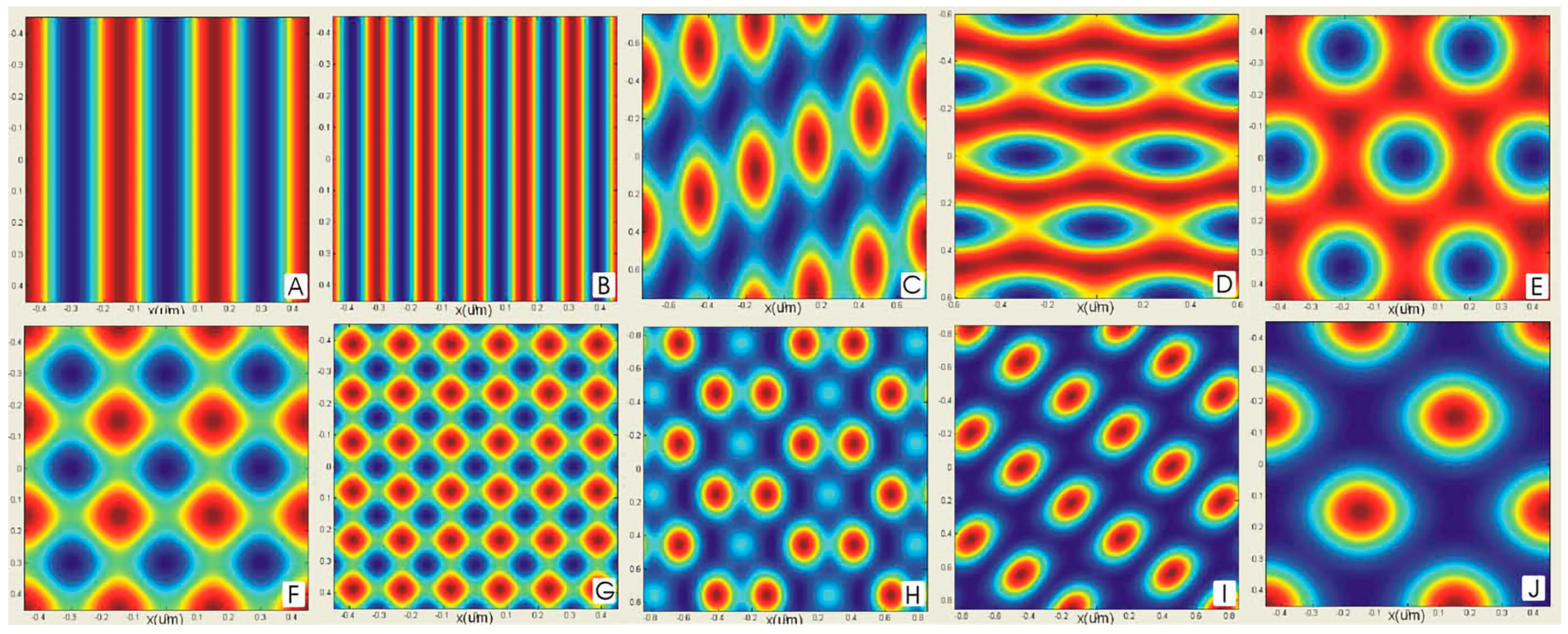
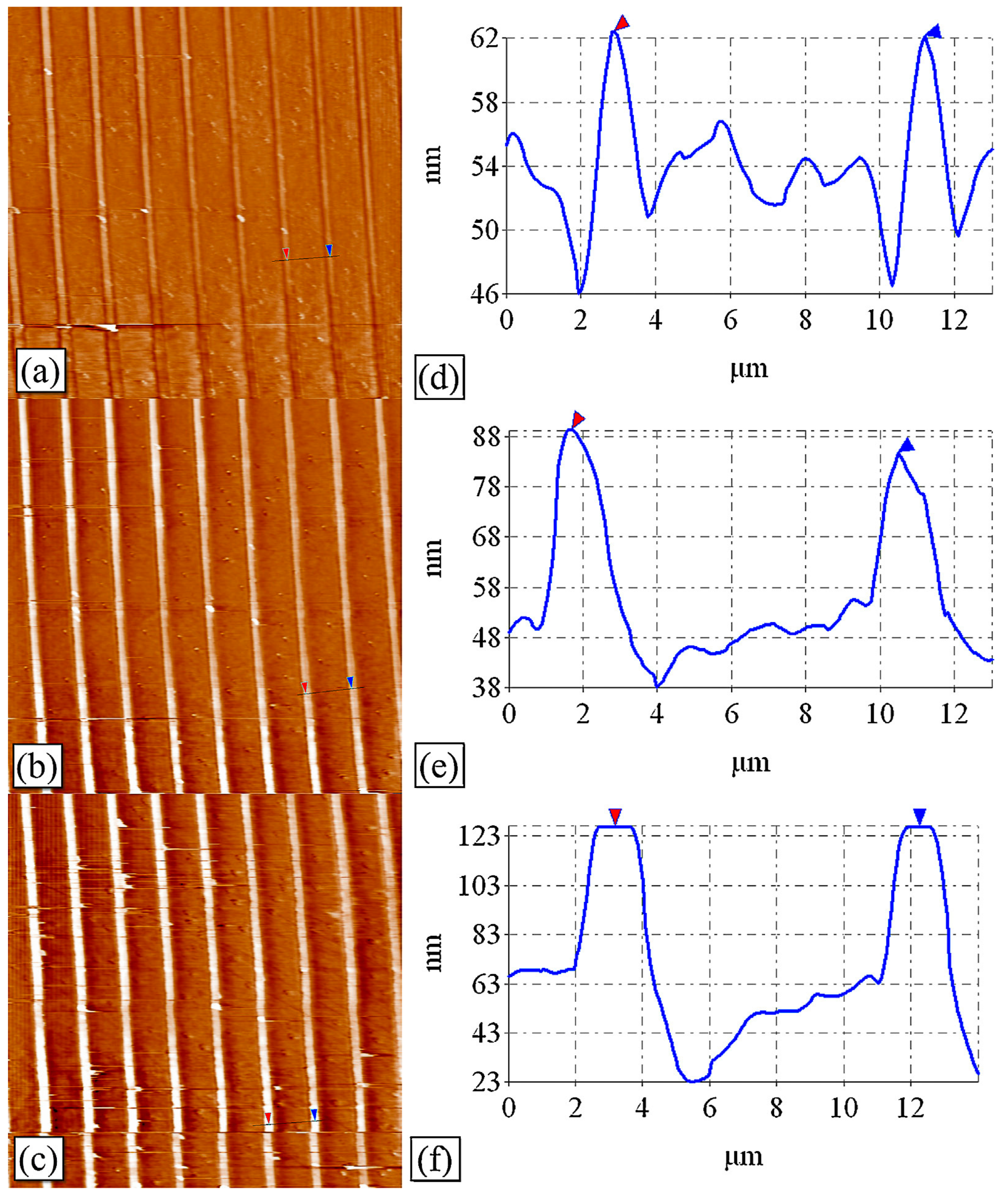
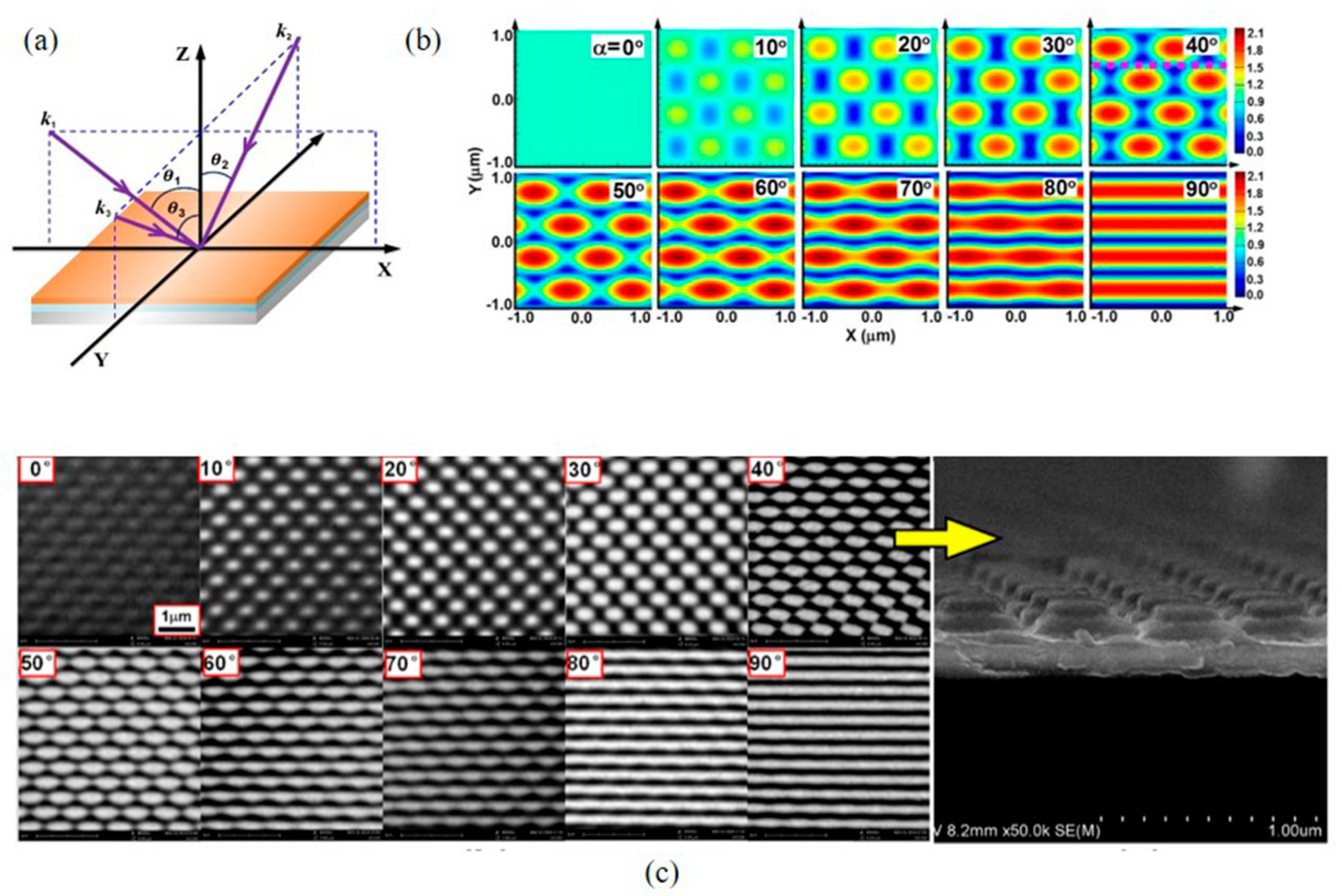
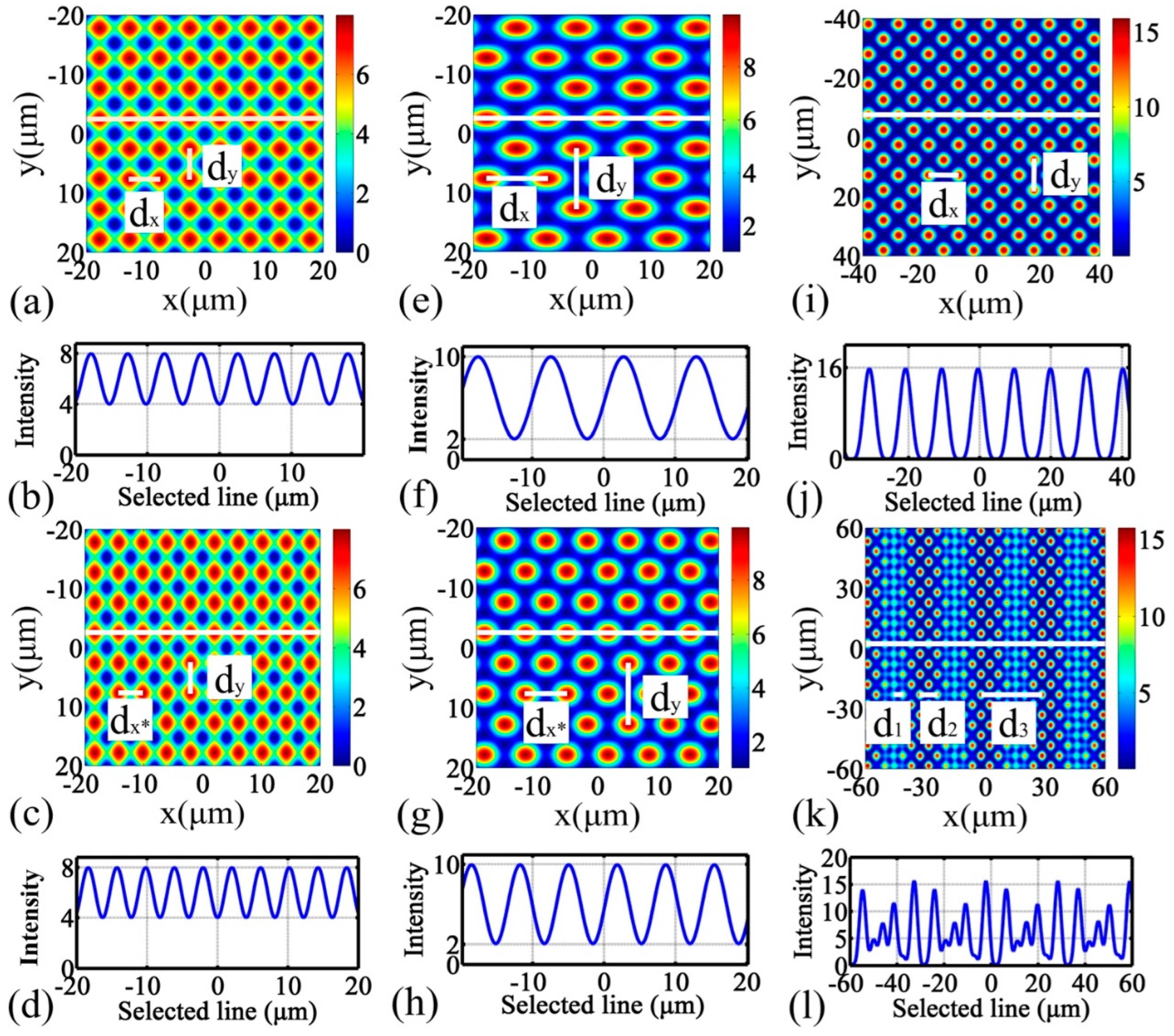
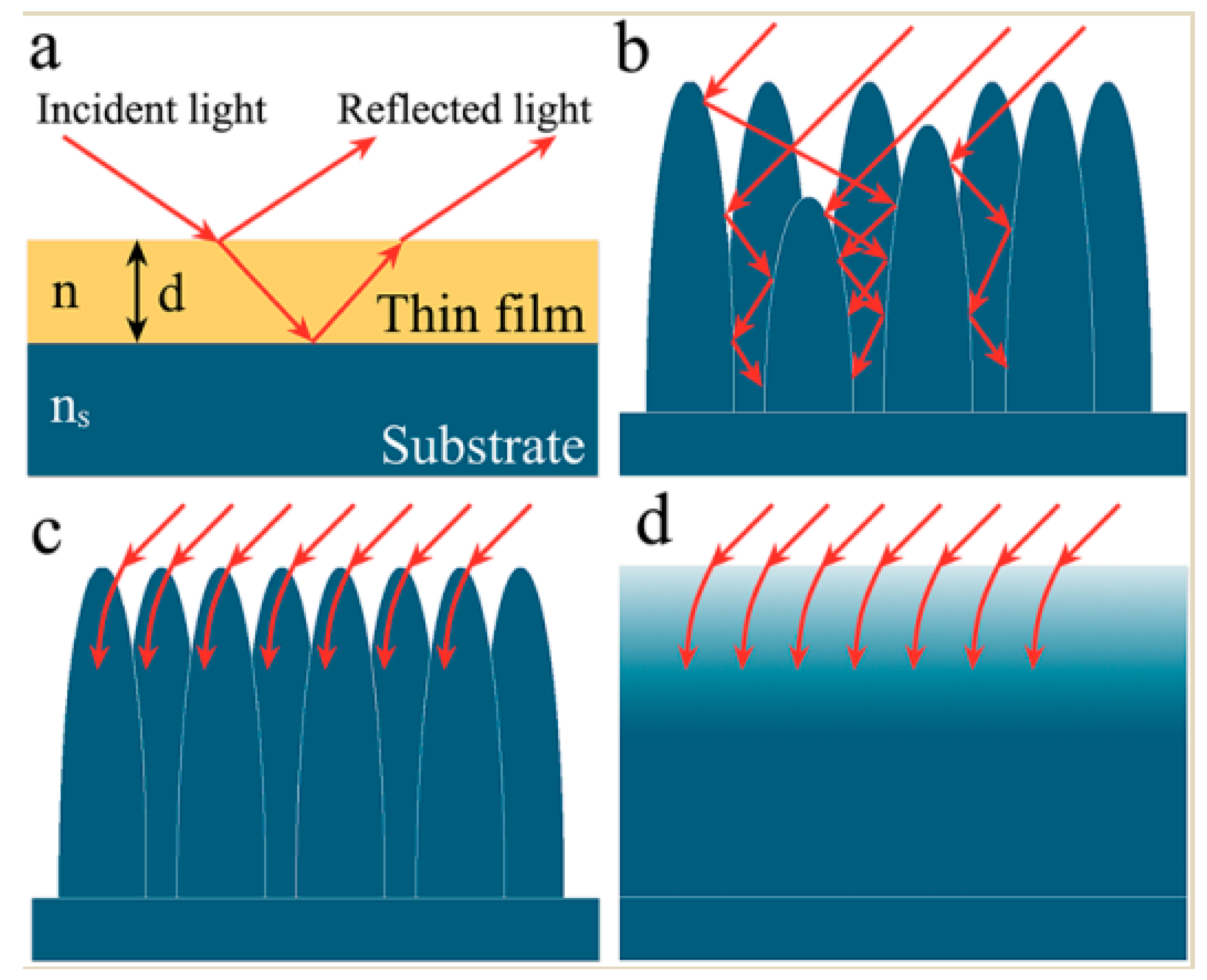



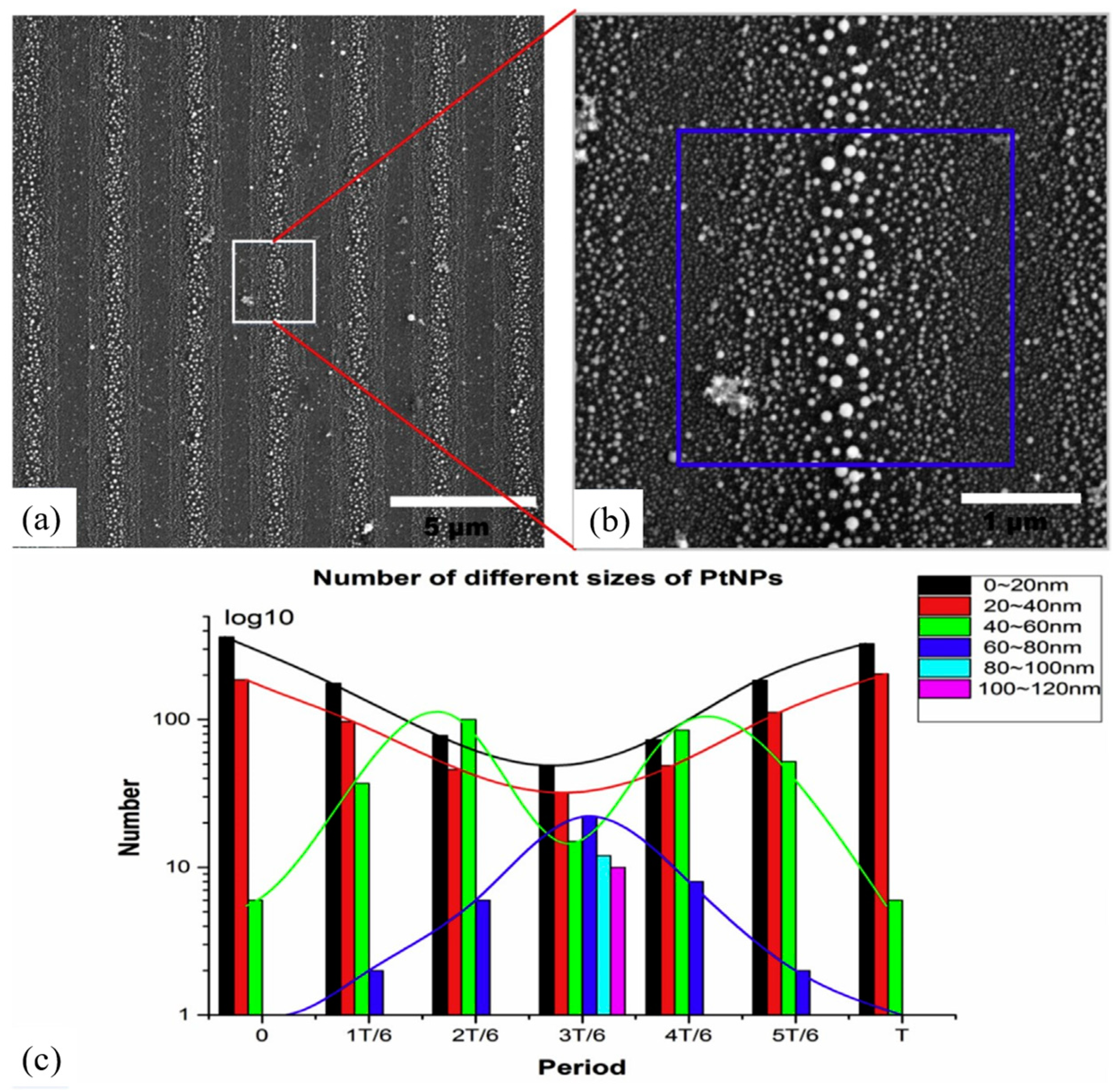

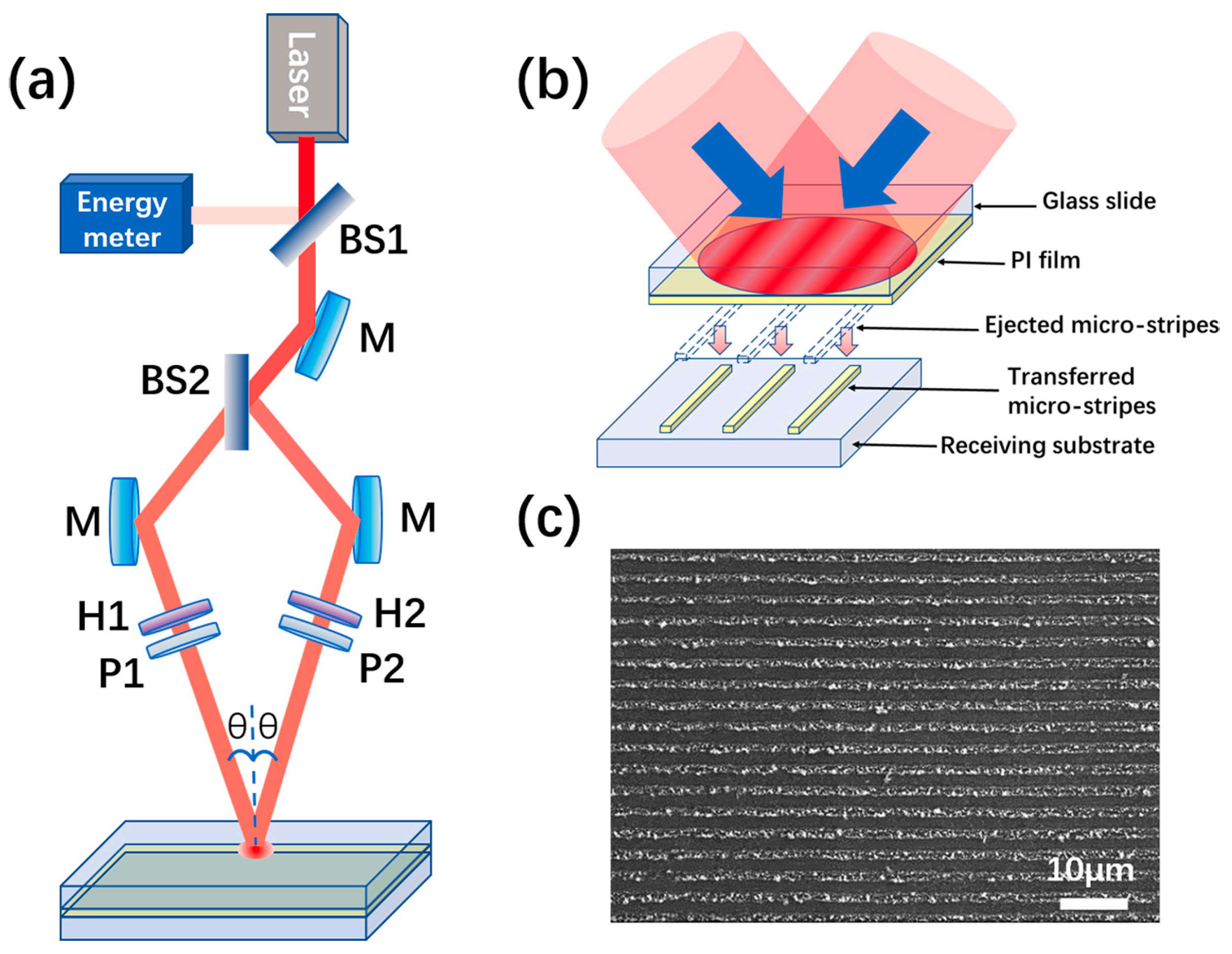
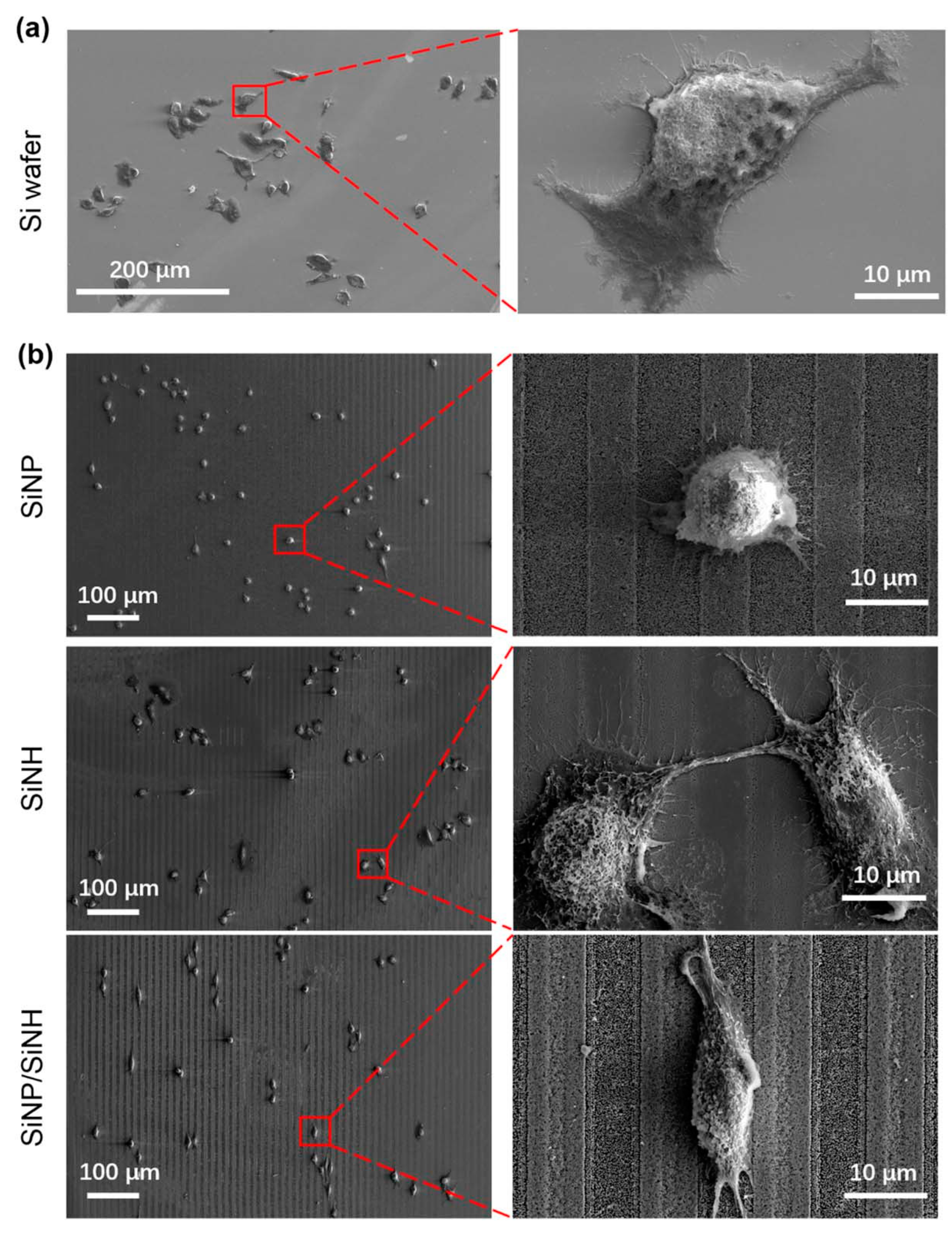


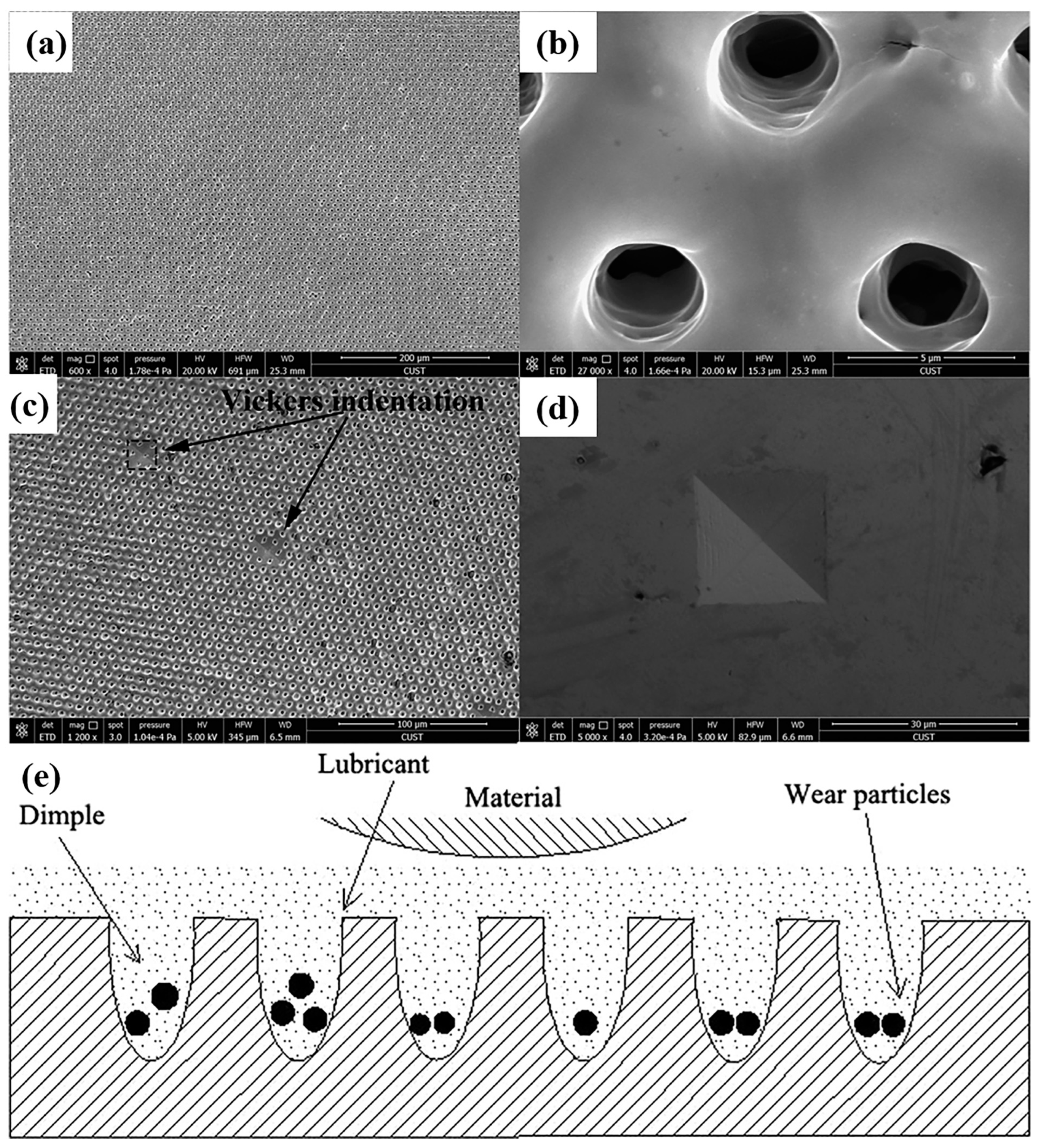
Disclaimer/Publisher’s Note: The statements, opinions and data contained in all publications are solely those of the individual author(s) and contributor(s) and not of MDPI and/or the editor(s). MDPI and/or the editor(s) disclaim responsibility for any injury to people or property resulting from any ideas, methods, instructions or products referred to in the content. |
© 2023 by the authors. Licensee MDPI, Basel, Switzerland. This article is an open access article distributed under the terms and conditions of the Creative Commons Attribution (CC BY) license (https://creativecommons.org/licenses/by/4.0/).
Share and Cite
Liu, R.; Cao, L.; Liu, D.; Wang, L.; Saeed, S.; Wang, Z. Laser Interference Lithography—A Method for the Fabrication of Controlled Periodic Structures. Nanomaterials 2023, 13, 1818. https://doi.org/10.3390/nano13121818
Liu R, Cao L, Liu D, Wang L, Saeed S, Wang Z. Laser Interference Lithography—A Method for the Fabrication of Controlled Periodic Structures. Nanomaterials. 2023; 13(12):1818. https://doi.org/10.3390/nano13121818
Chicago/Turabian StyleLiu, Ri, Liang Cao, Dongdong Liu, Lu Wang, Sadaf Saeed, and Zuobin Wang. 2023. "Laser Interference Lithography—A Method for the Fabrication of Controlled Periodic Structures" Nanomaterials 13, no. 12: 1818. https://doi.org/10.3390/nano13121818
APA StyleLiu, R., Cao, L., Liu, D., Wang, L., Saeed, S., & Wang, Z. (2023). Laser Interference Lithography—A Method for the Fabrication of Controlled Periodic Structures. Nanomaterials, 13(12), 1818. https://doi.org/10.3390/nano13121818




